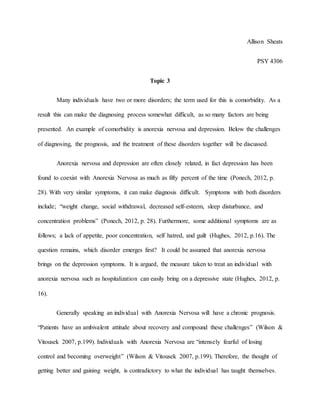
abnormal psy essay
- 1. Allison Sheats PSY 4306 Topic 3 Many individuals have two or more disorders; the term used for this is comorbidity. As a result this can make the diagnosing process somewhat difficult, as so many factors are being presented. An example of comorbidity is anorexia nervosa and depression. Below the challenges of diagnosing, the prognosis, and the treatment of these disorders together will be discussed. Anorexia nervosa and depression are often closely related, in fact depression has been found to coexist with Anorexia Nervosa as much as fifty percent of the time (Ponech, 2012, p. 28). With very similar symptoms, it can make diagnosis difficult. Symptoms with both disorders include; “weight change, social withdrawal, decreased self-esteem, sleep disturbance, and concentration problems” (Ponech, 2012, p. 28). Furthermore, some additional symptoms are as follows; a lack of appetite, poor concentration, self hatred, and guilt (Hughes, 2012, p.16). The question remains, which disorder emerges first? It could be assumed that anorexia nervosa brings on the depression symptoms. It is argued, the measure taken to treat an individual with anorexia nervosa such as hospitalization can easily bring on a depressive state (Hughes, 2012, p. 16). Generally speaking an individual with Anorexia Nervosa will have a chronic prognosis. “Patients have an ambivalent attitude about recovery and compound these challenges” (Wilson & Vitousek 2007, p.199). Individuals with Anorexia Nervosa are “intensely fearful of losing control and becoming overweight” (Wilson & Vitousek 2007, p.199). Therefore, the thought of getting better and gaining weight, is contradictory to what the individual has taught themselves.
- 2. In a study using the Morgan-Russell scales, it is “reported that children who experienced comorbid depression while ill with Anorexia Nervosa had a poorer outcome at 7-year follow-up compared with those who did not experience depression” (Hughes, 2012, p.18). Additionally one study showed, “adolescence with anorexia nervosa reported that comorbid depression predicted poorer health and financial functioning at 9-to14-year follow-up” (Hughes, 2012, p.18). With such daunting findings is there hope to successful treatment of the individuals? When treating Anorexia Nervosa comorbid with depression, one source argues, to assess and treat depressive disorders first among those present with eating or weight problems as this may also facilitate recovery from Anorexia Nervosa (Ponech, 2012, p. 28). Thus, implies the depression should be addressed before trying to tackle the eating disorder. Typically, medication does not aide in any way in the recovery process for Anorexia Nervosa, therefore a holistic approach to healing has been found to be more beneficial (Ponech, 2012, p.30). Recently there has been a “growing interest in utilizing group therapy for individuals diagnosed with AN as the research shows this population is difficult to treat successfully, and group therapy may add a more holistic approach to healing” (Ponech, 2012, p. 32). Group therapy had shown that the “Clients can be very helpful to one another in the group therapeutic process by offering support, reassurance, suggestions, insight, and by sharing their experience with similar problems” (Ponech, 2012, p.38). Additionally, the individuals see the group members “as representing the real world and can be counted on for spontaneous and truthful reactions and feedback”, as well offering an important contribution to the individual’s improvement (Ponech, 2012, p.38). Family therapy has been found to be very beneficial, as families tend to have much hold over the individual. In adolescence, this is extremely helpful as the parent can take “complete control over their anorexic child’s eating and weight and are coached to find effective means of
- 3. doing so. Once the child begins to comply with parental authority, external control is gradually faded”. (Wilson &Vitousek 2007, p.200). This turn can almost reprogram the child’s thought process, by using authority to its advantage. “Cognitive behavioral therapy is the most frequently tested individual treatment for anorexia nervosa” (Wilson & Vitousek 2007, p.201), thus this is typically the route used when treating an individual with anorexia nervosa and depression. Within studies it was found that there is “no empirical basis for the widespread use of antidepressants with this population” (Wilson & Vitousek 2007, p. 201). Therefore a thought based therapy would undoubtedly, benefit the individual the most. In fact, in group therapy the instructor is encouraged to “include a cognitive therapeutic approach by offering explicit instruction about the nature of clients’ concerns or life situations and examining clients’ misconceptions and self-defeating responses” (Ponech, 2012, p.37). The high comorbidity rate of anorexia nervosa and depression is addressed above. Both disorders offer similar symptoms making it especially difficult to diagnose either disorder; as well as greatly complicating the prognosis. With the intervention of holistic therapies versus medication, the individual is able to recover more effectively.
- 4. Bibliography HUGHES, E.K (2012). Comorbid depression and anxiety in childhood and adolescent anorexia nervosa: Prevalence and implications for outcome. Clinical Psychologist, 16(1), 15-24. Ponech, H., &McBride, D. (2012). Coming Together to Calm the Hunger: Group Therapy Program for Adults Diagnosed with Anorexia Nervosa. Online Submission Wilson, G., Grilo, C.M., & Vitousek, K.M. (2007). Psychological treatment of eating disorders. American Psychologist, 62(3), 199-216